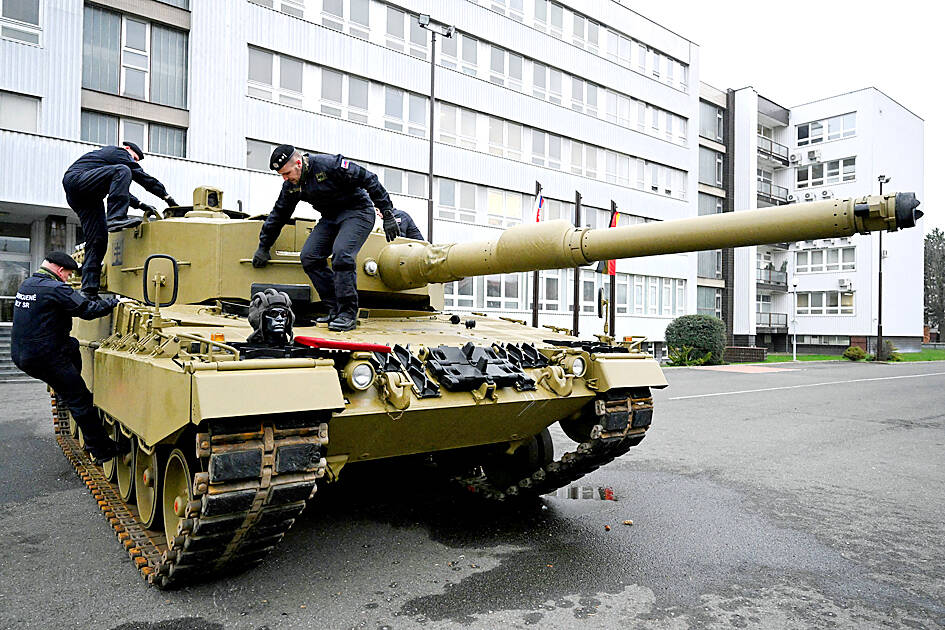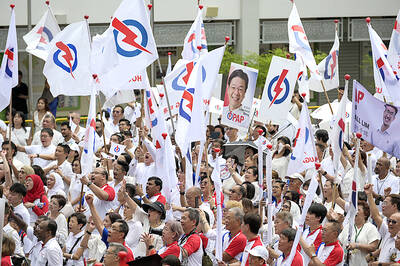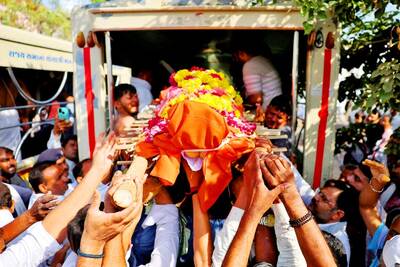Germany would not stand in the way if Poland wants to send its Leopard 2 tanks to Ukraine, German Minister of Foreign Affairs Annalena Baerbock said late on Sunday, signaling a possible breakthrough for Ukraine as it tries to bolster its forces ahead of an expected new Russian offensive.
Eleven months after Russia invaded its southern neighbor, the fighting is centered on the town of Bakhmut in Ukraine’s east, where Russia’s Wagner mercenaries and Ukrainian forces have been locked in a battle of attrition.
The Russian Ministry of Defense said for the second straight day on Sunday that its forces were improving their positions in Ukraine’s southern region of Zaporizhzhia, although a Ukrainian military spokesperson told the state broadcaster the situation there was “difficult,” but stable.

Photo: Reuters
Reuters was not able to independently verify battlefield accounts.
Ukrainian officials have been calling on Western allies to supply them with the modern German-made tanks for months, but Berlin has held back from sending them or allowing other NATO countries to do so.
Leopard tanks, which are held by an array of NATO countries, but whose transfer to Ukraine requires Berlin’s approval, are seen by defense experts as the most suitable for Ukraine.
Western allies last week pledged billions of dollars in weapons for Ukraine, but they failed to persuade Germany to lift its veto on providing the tanks.
However, in an apparent shift in Germany’s position, Baerbock said her government would not block Poland if it were to send its Leopard 2 tanks without German approval.
“For the moment the question has not been asked, but if we were asked we would not stand in the way,” she told France’s LCI TV, when asked about her government’s reaction to any such Polish decision.
Germany has been under heavy pressure to let Leopards go to Ukraine, but German Chancellor Olaf Scholz is traditionally skeptical of military involvements and wary of sudden moves that could trigger Russia to escalation.
Baerbock’s remarks appeared to go further than Scholz’s comments at a summit in Paris earlier on Sunday that all decisions on weapons deliveries would be made in co-ordination with allies, including the US.
Ukraine says the heavily armored battle tanks would give its ground troops more mobility and protection ahead of a new Russian offensive expected in coming months.
However, Germany has appeared to have tied any such contribution to a US move to send its Abrams tanks, something US officials have said they are reluctant to do because the vehicles are complicated to maintain.
US lawmakers in Sunday pushed their government on Sunday to export M1 Abrams main battle tanks to Ukraine, saying that even sending a symbolic number would be enough to push European allies to do the same.
Britain recently said it was supplying 14 Challenger 2 tanks to Ukraine. British Secretary of State for Foreign, Commonwealth and Development Affairs James Cleverly on Sunday said it still wanted an international deal to provide Ukraine with the German-made tanks.
French President Emmanuel Macron said he did not rule out the possibility of sending Ukraine Leclerc tanks.
Last week, the Kremlin’s spokesman said Western countries supplying additional tanks to Ukraine would not change the course of the conflict, but would add to the problems of Ukrainians.
A close ally of Russian President Vladimir Putin on Sunday said that deliveries of offensive weapons to Kyiv that threaten Russia’s territories would lead to a global catastrophe and make arguments against using weapons of mass destruction untenable.

ECONOMIC WORRIES: The ruling PAP faces voters amid concerns that the city-state faces the possibility of a recession and job losses amid Washington’s tariffs Singapore yesterday finalized contestants for its general election on Saturday next week, with the ruling People’s Action Party (PAP) fielding 32 new candidates in the biggest refresh of the party that has ruled the city-state since independence in 1965. The move follows a pledge by Singaporean Prime Minister Lawrence Wong (黃循財), who took office last year and assumed the PAP leadership, to “bring in new blood, new ideas and new energy” to steer the country of 6 million people. His latest shake-up beats that of predecessors Lee Hsien Loong (李顯龍) and Goh Chok Tong (吳作棟), who replaced 24 and 11 politicians respectively

Archeologists in Peru on Thursday said they found the 5,000-year-old remains of a noblewoman at the sacred city of Caral, revealing the important role played by women in the oldest center of civilization in the Americas. “What has been discovered corresponds to a woman who apparently had elevated status, an elite woman,” archeologist David Palomino said. The mummy was found in Aspero, a sacred site within the city of Caral that was a garbage dump for more than 30 years until becoming an archeological site in the 1990s. Palomino said the carefully preserved remains, dating to 3,000BC, contained skin, part of the

Russian hackers last year targeted a Dutch public facility in the first such an attack on the lowlands country’s infrastructure, its military intelligence services said on Monday. The Netherlands remained an “interesting target country” for Moscow due to its ongoing support for Ukraine, its Hague-based international organizations, high-tech industries and harbors such as Rotterdam, the Dutch Military Intelligence and Security Service (MIVD) said in its yearly report. Last year, the MIVD “saw a Russian hacker group carry out a cyberattack against the digital control system of a public facility in the Netherlands,” MIVD Director Vice Admiral Peter Reesink said in the 52-page

‘WATER WARFARE’: A Pakistani official called India’s suspension of a 65-year-old treaty on the sharing of waters from the Indus River ‘a cowardly, illegal move’ Pakistan yesterday canceled visas for Indian nationals, closed its airspace for all Indian-owned or operated airlines, and suspended all trade with India, including to and from any third country. The retaliatory measures follow India’s decision to suspend visas for Pakistani nationals in the aftermath of a deadly attack by shooters in Kashmir that killed 26 people, mostly tourists. The rare attack on civilians shocked and outraged India and prompted calls for action against their country’s archenemy, Pakistan. New Delhi did not publicly produce evidence connecting the attack to its neighbor, but said it had “cross-border” links to Pakistan. Pakistan denied any connection to